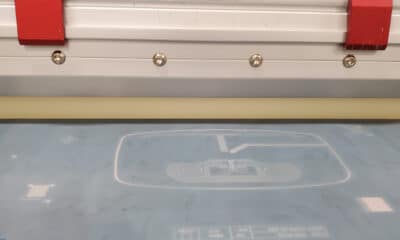MY LAST COLUMN focused on the ongoing history of print, its remaining importance, and its growth as printing continues to decorate and drive the fabric of the society we live in. (You know – the usual AndyMac bull$#%@.) Every printer or business that relies on printing to create their unique product seems to be developing in the economy: Locally, here on Vancouver Island. Nationally. Internationally. Graphic printing. Decorative printing. Industrial printing. You name it.
Digital printing has created entirely new market segments over the last 20 years. Textile decoration is ubiquitous and spreading (or should I say sublimating), and all that cheap-ass electronica that now dominates every minute of people’s lives? Every piece of it has printed parts. If you want to hear a prediction from the last person not to have a cellphone, it’s simply that none of it is going away soon. Smartphones are the TV remote of the internet of things. And it’s all printed.
It would seem there will be lots of work for skilled press operators and all the other techs on the production team. Our presses and other production machinery are getting more sophisticated and automated. Packaging and functional print are the areas predicted to grow in the future. That’s good news for screen printers, and most everyone else in the printing universe. Maybe not lithographers or stencil cutters. Times change. Industries evolve. Definitions change. Or do they?
The Department of Labor’s Bureau of Labor Statistics announced in January that “printer,” “screen printer,” and “support activities for printing” are no longer official jobs as far as BLS is concerned. Apparently, they are “statistically irrelevant.” Perhaps they checked on stencil cutting, found one guy in Buda, Texas, who still does it, and killed the entire category.
The Washington Post, in a rare story to mention screen printing, reported about the excommunication in February. “The broad sector that includes printing has shed about a third of its jobs since the start of the Great Recession – more than every sector but clothing manufacturing, which also no longer has enough US jobs to merit many lines in the database.”
Michael Makin, president and CEO of Printing Industries of America, has a different take. “Printing Industries of America (PIA) is disappointed – but not surprised – to learn of the Bureau of Labor Statistics’ announcement that the agency would no longer track jobs related to commercial print, screen printing, and support activities for printing,” Makin says.
Advertisement
“The disappointment is shared by the approximately 800,000 workers in the printing, packaging, and publishing industries who go to work every morning knowing that their jobs are relevant to the nation’s manufacturing economy.”
“The lack of surprise relates to the fact that PIA has urged the Bureau of Labor Statistics multiple times over a number of years to revise its outdated definition of the printing industry,” Makin says. “Print has and will continue to evolve as a media, and printers will continue to transition with a diverse mix of processes, products, and ancillary services. Unfortunately, the BLS has demonstrated it is less than interested in keeping up with the times and in collaborating with PIA on modern industry definitions that would more accurately reflect that print is alive and thriving as a key manufacturing sector. Simply put, it is the BLS data as collected that is irrelevant, not printing and graphics communications jobs.”
Makin is correct. BLS doesn’t count many of you readers as being in the print industry. They don’t count our specialized graphics people, in-plant printing operations, or the dedicated artists, printers, processors, and installers in digital graphic or textile shops. They don’t count electronics printers, glass and bottle printers, or credit card manufacturers. They exclude textile printers. They do include print making under the category of craft and fine artist (2018).
I’ve experienced the same problem in Canada, where “printer” is not classified as a skilled trade by the Industry Training Authority (ITA). This lack of recognition manifests itself in support for education, training, industry growth, and rebuilding our manufacturing sectors. If the government doesn’t recognize it as a trade, or segment of industry, three things happen:
- It kills access to any job-specific training funds under skills development programs.
- It blocks access to young workers. (How will they know there is a career path if it’s not listed with other job categories?)
- It cripples the potential for sectors of print that could grow domestically. As print has evolved into a manufacturing process used in electronics, medical devices, and alternative energy (among many other distinct industrial sectors), the print capabilities, knowledge, and technological know-how required in these promising areas requires support.
What should scare us is the Department of Labor’s lack of interest in changing their definitions of print and printers to reflect the wide diversity and rapid technological changes that have transformed the industry. This begs the question: What other sectors of the economy are being adversely affected by the inability of a government department to change outdated criteria and labels to reflect technological change? We’re special, but we’re not that special.
Speaking of special: This one’s for my editor/publisher/pal Steve Duccilli. Not sure what the future brings, but I will miss giving you gray hairs every deadline. We’re not done yet.
Advertisement

 Case Studies2 months ago
Case Studies2 months ago
 Art, Ad, or Alchemy2 months ago
Art, Ad, or Alchemy2 months ago
 Andy MacDougall2 months ago
Andy MacDougall2 months ago
 Columns3 weeks ago
Columns3 weeks ago
 Editor's Note3 weeks ago
Editor's Note3 weeks ago
 Marshall Atkinson3 weeks ago
Marshall Atkinson3 weeks ago
 Thomas Trimingham2 months ago
Thomas Trimingham2 months ago
 Case Studies3 weeks ago
Case Studies3 weeks ago















